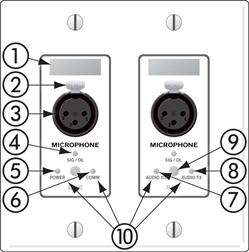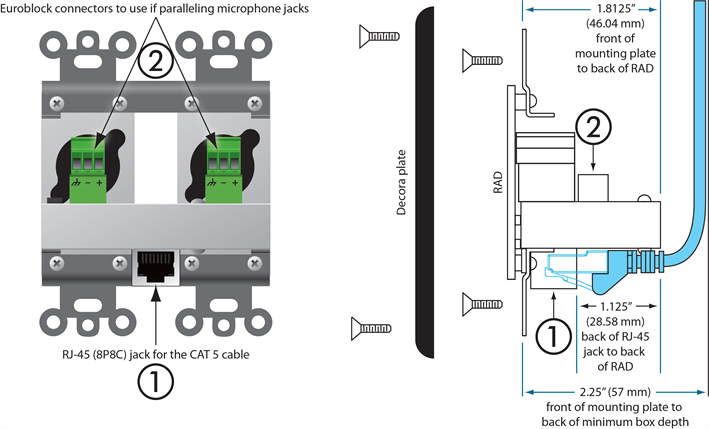The shielded CAT 5e cable that connects the RAD to HAL also provides power to the RAD as well as a path for data communications. Data communications makes it possible to control the RAD’s configuration settings, view status information, and update a RAD’s firmware – all from the host HAL device. The following picture illustrates how the four twisted pairs within the shielded CAT 5e cable are utilized.
- The orange pair is reserved for data communications between the RAD and HAL. Data communications is needed for such things as sending configuration information from HAL to the RAD, sending firmware updates from HAL to the RAD, and sending status information from the RAD to HAL.
note: Configuration information for a specific RAD (for example, LED intensity, microphone sensitivity, and RAD and channel names) is stored in the HAL device, not in the RAD. This makes it easy to swap in a new RAD, if necessary, without losing configuration data.
- The green and blue pairs carry two channels each of balanced, differential, digital audio. Tx refers to audio that the RAD sends to the HAL. Rx refers to audio that the RAD receives from HAL.
- The brown pair provides 24 VDC power and ground for the RAD. This is (obviously) the wire you should check if it appears a RAD is not receiving power.
note: Digital Remotes use only the orange pair (for data communications) and the brown pair (for power).
RAD Grounding
note: For some electrical systems (e.g., isolated grounding systems - sometimes called a single point or star ground) the grounding procedure outlined above may short two fingers of the building ground system. If this creates a problem, then use of non-conductive junction boxes, or insulating mounting methods are recommended (or very much required!).
note: The RAD16z is grounded differently than the above. The RAD16z galvanicaly isolates its RJ-45 jack, cable shield and grounded twist, and the HAL/equipment room ground from its logic and audio I/O grounds. This means no special ground is needed. This provides 500-volts galvanic isolation as well as standard Ethernet-like electrostatic protection as the RAD16z cables get hot plugged and unplugged.




 The Generate Device Labels dialog box displays.
The Generate Device Labels dialog box displays.


 See Also
See Also